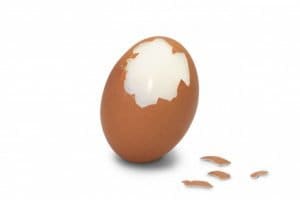 We’ve all been there.
We’ve all been there.
Staring hungry at a delicious hard boiled egg only to find ourselves struggling to get the peel off. What are we inevitably left with? A mutilated egg and despair.
But why is this? The answer is actually quite interesting!
It all comes down to chemistry; pH level to be precise. For those who don’t know, pH refers to a substances acidity level. Anything below 7 is considered acidic and anything over 7 is considered to be alkaline. 7 itself is neutral.
When it comes to peeling hard boiled eggs, the more alkaline (the higher the pH) the easier it is to peel. The more acidic (the lower the pH) the harder it is to get that darn shell off. The reason for this are the relationship between the proteins in the egg white and the keratin contained in the egg’s membrane. At a lower pH, these proteins will bind far more tightly to the keratin, making it extremely difficult to peel.
So how can you tell whether or not your eggs have a high or low pH? That’s actually fairly simple!
Fresher eggs have a much high pH level than those that have been left in the refrigerator for a few days. As the eggs sit, they become more alkaline, thus the bond between the protein and the keratin is weaker allowing for easier peeling.
This is the reason so many people add baking soda and other alkaline substances to their water when they boil eggs; they’re attempting to lower the level of acidity. A great idea for fresh eggs right off the shelf, but not necessary for older ones.
